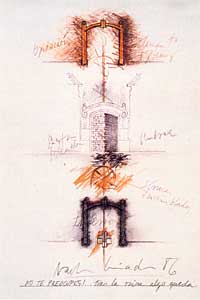Nacho Criado…tras la ruina
Nacho Criado (Mengíbar, Jaén 1943) is an artist whose complex development can in no way be reduced to Conceptualism, of which he may be considered one of the pioneers in Spain. His artistic production began in an Informalist style closely related to Italian Spatialism. He continued with a Minimalism tinged with Arte Povera, introducing organic material, and from there went on to installations and Land Art in Cuenca, until he reached his most characteristic—Conceptual—stage, which also includes examples of Process Art, performances, etc. His career demonstrates great consistency, and in his development he has used media such as photography, film, graphic work and publications, performances, sculptures and environments related to the poetics of installations. Since his youth Nacho Criado has been an enthusiast of the work of Rothko and Duchamp, to whom he has referred in many of his works and interventions and included in his Homenajes (Tributes), a series that began with the Homenaje a Rothko (Tribute to Rothko) in the Galería Sen in Madrid in 1970. That tribute was a manifestation of the crisis of the traditional artistic object, an inaugural work that has been linked to Conceptual Art. In 1971 he met Hidalgo and Marchetti, members of ZAJ, whose influence proved decisive, and the relationship has continued through collaborations, especially photographic, and performances. The combination of materials and intentions in Nacho Criado’s work sometimes comes close to Arte Povera or Environmental Art or, more often, Conceptual Art. The presence of elements referring to daily life—family portraits, domestic objects, etc.—is very frequent, and their interpretation comes closer to an archaeology of what it is to be human than to an autobiographical viewpoint. His work is organised around a nucleus of essential themes that generate an environment in which he disseminates objects or events that provide a counterpoint. The circle and downfall, the form of the ellipse and anamorphism are constant features in Nacho Criado’s work, from his early Minimal pieces to the Conmemoraciones (Commemorations) of 1995-96. Another aspect to which Nacho Criado gives high priority is the experience of time or the search for the stealthy time of transposition and transition. Setting out from a personal aesthetic discourse based on the linking of ideas, he pursues a creative process subject to the rules of mnemonics and submitted to modifications in time and variations introduced by the artist, converting them into genuine works of Process Art. A considerable part of Nacho Criado’s work focuses on materials such as glass or the dome-like physiognomy of space and on accidents and processes of time. Some of these pieces can be considered to function autonomously, with their process quality acquiring particular importance—for example, in some of the more provocative works in which collaborating agents intervene, such as In/digestión (In/digestion, 1973-76), where termites devoured a pile of art magazines, or the series of small wooden sculptures devoured by insects, or the intervention of phenomena such as moisture and its effects and the activity of moulds in Umbra Zenobia (1991). Since the presentation in 1977 of Quotidianum, the first of a long series of performances, he has remained interested in performance not as a specific artistic genre but as something that can be used in the diffusion of ideas, a way of adopting and sustaining by one’s presence the position taken in the act of creation. The exhibitions that he has presented in recent years include MaDe in…, shown in Guadalajara (Mexico) and Ljubljana (Slovenia) in 1994, La mirada sedienta (Granada 1995), Brindis (Cáceres 1995), …más al Sur (Seville 1996), En tiempo furtivo (Santiago de Compostela–Barcelona 1997), and Lo que queda (Variaciones) (Madrid 1999). The present exhibition consists of three series of works: the Minimal pieces, the Conmemoraciones and some of the works connected with the theme of La voz que clama en el desierto (The Voice Crying in the Wilderness). The title of the exhibition is provided by the arch ¡No te preocupes!… tras la ruina algo queda (Don’t Worry! … After the Ruin Something Remains, 1986), and the central area in the Embajador Vich room is occupied by a piece made specifically for the occasion. Thus a structural relationship between the various periods of this artist is offered, showing the continuity of concerns such as reduction of form or the mise-en-scène of ideas, in an itinerary beginning with the threshold piece and ending with the earliest pieces, connected with Minimalism and made between 1966 and 1970, including the fundamental Homenaje a Rothko (1970).



